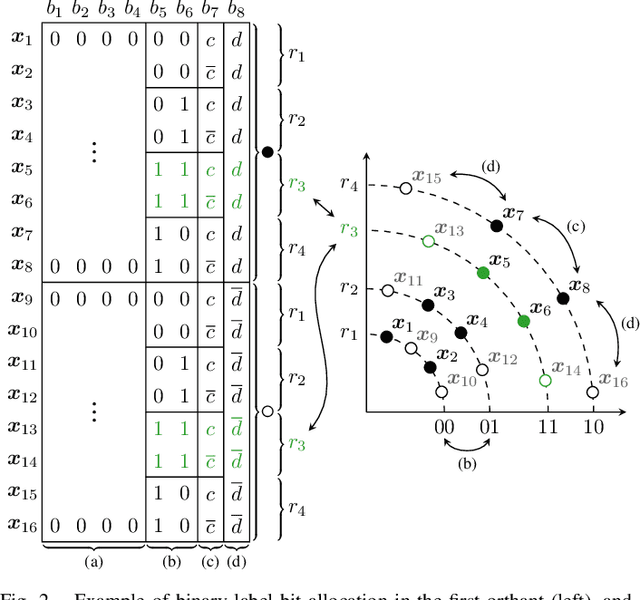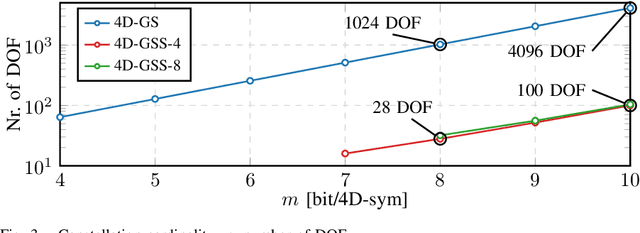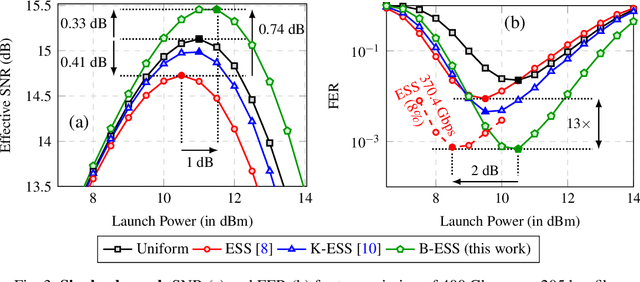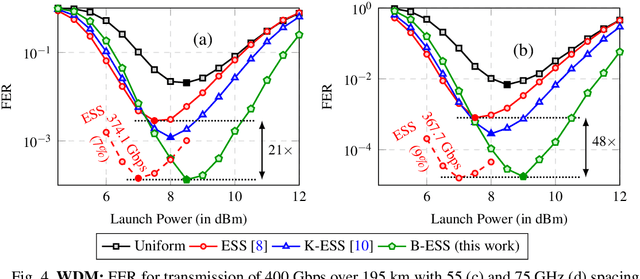Chigo Okonkwo
5.7 Tb/s Transmission Over a 4.6 km Field-Deployed Free-Space Optical Link in Urban Environment
Mar 27, 2025Abstract:We transmitted 5.7 Tb/s over a 4.6 km free-space optical link in an urban environment, spanning the city of Eindhoven, the Netherlands, using a 1.1 THz wide wavelength-division multiplexed signal.
Mitigation of Polarization-Induced Fading in Optical Vector Network Analyzer for the Characterization of km-scale Space-Division Multiplexing Fibers
Oct 10, 2024Abstract:We propose an optimized optical vector network analyzer with automatic polarization control to stabilize the reference arm polarization throughout the sweep range. We demonstrate this technique, successfully removing the polarization-induced fading and measurement distortions in insertion loss by characterizing a 10 km multi-core fiber.
Co-propagation of Classical and Continuous-variable QKD Signals over a Turbulent Optical Channel with a Real-time QKD Receiver
Jan 19, 2024Abstract:We demonstrate classical and quantum signal co-propagation over a turbulent free-space channel with 3 Tbit/s throughput and record 2.7 Mbit/s secret-key rate. Our real-time GPU-based receiver assessed quantum signal integrity under different turbulence scenarios for the first time.
Adaptive Reconciliation for Experimental Continuous-Variable Quantum Key Distribution Over a Turbulent Free-Space Optical Channel
Dec 21, 2023


Abstract:We experimentally demonstrate adaptive reconciliation for continuous-variable quantum key distribution over a turbulent free-space optical channel. Additionally, we propose a method for optimising the reconciliation efficiency, increasing secret key rates by up to 8.1%.
A Simplified Method for Optimising Geometrically Shaped Constellations of Higher Dimensionality
Jul 11, 2023



Abstract:We introduce a simplified method for calculating the loss function for use in geometric shaping, allowing for the optimisation of high dimensional constellations. We design constellations up to 12D with 4096 points, with gains up to 0.31 dB compared to the state-of-the-art.
On Optimum Enumerative Sphere Shaping Blocklength at Different Symbol Rates for the Nonlinear Fiber Channel
Jul 08, 2022


Abstract:We show that a 0.9 dB SNR improvement can be obtained via short-blocklength enumerative sphere shaping for single-span transmission at 56 GBd. This gain vanishes for higher symbol rates and a larger number of spans.
Introducing 4D Geometric Shell Shaping
Jun 07, 2022



Abstract:Four dimensional geometric shell shaping (4D-GSS) is introduced and evaluated for reach increase and nonlinearity tolerance in terms of achievable information rates and post-FEC bit-error rate. A format is designed with a spectral efficiency of 8 bit/4D-sym and is compared against polarization-multiplexed 16QAM (PM-16QAM) and probabilistically shaped PM-16QAM (PS-PM-16QAM) in a 400ZR-compatible transmission setup with high amount of nonlinearities. Numerical simulations for a single-span, single-channel show that 4D-GSS achieves increased nonlinear tolerance and reach increase against PM-16QAM and PS-PM-16QAM when optimized for bit-metric decoding (RBMD). In terms of RBMD, gains are small with a reach increase of 1.6% compared to PM-16QAM. When optimizing for mutual information, a larger reach increase of 3% is achieved compared to PM-16QAM. Moreover, the introduced GSS scheme provides a scalable framework for designing well-structured 4D modulation formats with low complexity.
4D Geometric Shell Shaping with Applications to 400ZR
Jun 07, 2022

Abstract:Geometric shell shaping is introduced and evaluated for reach increase and nonlinearity tolerance in terms of MI against PM-16QAM and PS-PM-16QAM in a 400ZR compatible transmission setup.
Experimental Validation of Sequence-Wise Predistorter for Evaluation of Geometrically Shaped 128-QAM
May 11, 2022

Abstract:A predistorter for transmitter nonlinearities is applied to the evaluation of a geometrically shaped constellation, such that constellation points are transmitted correctly during the evaluation of the geometrically shaped constellation.
Mitigating Nonlinear Interference by Limiting Energy Variations in Sphere Shaping
Jan 10, 2022



Abstract:Band-trellis enumerative sphere shaping is proposed to decrease the energy variations in channel input sequences. Against sphere shaping, 0.74 dB SNR gain and up to 9% increase in data rates are demonstrated for single-span systems.
 Add to Chrome
Add to Chrome Add to Firefox
Add to Firefox Add to Edge
Add to Edge